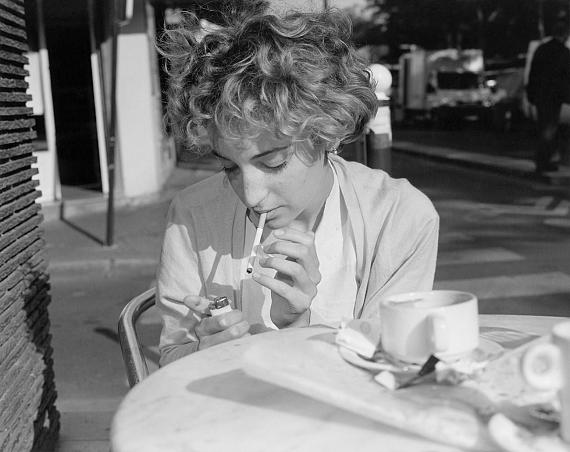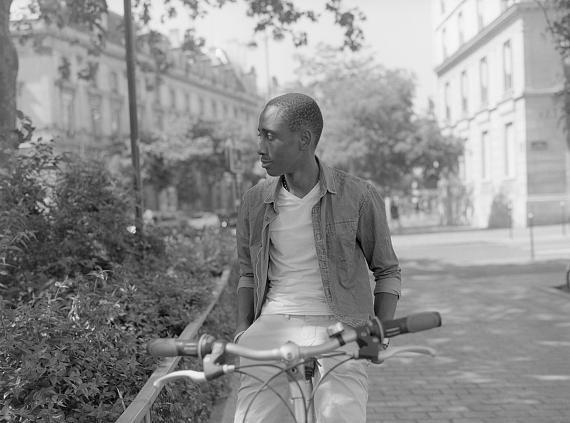
Bus ligne 20, Belleville, 2020
Gelatin silver print, printed by the artist
© Thomas Boivin
Courtesy Les Douches la Galerie, Paris
Thomas Boivin »
Ici
Belleville, Ménilmontant, Place De La République
Exhibition: 17 Feb – 6 Apr 2024
Sat 17 Feb 14:00 - 20:00

Les Douches La Galerie
54 Rue Chapon
75003 Paris
+33 1-78 94 03 00
contact@lesdoucheslagalerie.com
www.lesdoucheslagalerie.com
Wed-Sat 14-20+

Portrait, Place de la République, 2019-2023
Gelatin silver print, printed by the artist
© Thomas Boivin
Courtesy Les Douches la Galerie, Paris
Thomas Boivin
Ici. Belleville, Ménilmontant, Place De La République
Exhibition: February 17 - April 6, 2024
Opening: February 17, 2 – 8pm
Since 2010, Thomas Boivin has been pursuing his photographic work in the northeast of Paris, wandering around his home, strolling the streets, always favoring beautiful light. Portraits of passersby or residents he meets in multicultural neighborhoods and with whom he often establishes a dialogue, urban landscapes that bring out neglected corners, and his own black and white prints, with their subtly balanced shades of gray, have become his signature. Embracing the Paris of Brassai, Marcel Bovis or Robert Doisneau, Thomas Boivin doesn’t indulge in nostalgia either but prefers to draw inspiration from the contemporary American scene, where Mark Steinmetz and Judith Joy Ross, portraitists extraordinaire, are notorious among his influences. When he’s not photographing friends and family, or leaving the house, Thomas Boivin explores still lifes, echoing a pictorial tradition that also reflects his pronounced taste for simplicity and beauty.
How did you become a photographer?
Shortly after studying illustration at the Art Décoratifs de Strasbourg, I bought a digital camera –
but quickly switched to a Leica - and got into the habit of taking walks with my camera or in the middle
of my days, hunched over a drawing table. It wasn’t long before photography took over.
Did you immediately choose to photograph in black and white?
It was initially a rational choice: about a dozen years ago, black and white film was still cheap, and I
didn’t have much money. At the time, it was possible to order film directly from the United States by the
hundreds, without the trouble of customs fees. In any case, I was attracted to the idea of developing
film by myself, and black and white film easily allowed that. That being said, I have used color film from
time to time and will perhaps take it more seriously someday.
What role does light play in your work?
I mostly like strong and pure lights and rarely go out on overcast days. I photograph almost exclusively
in the morning, not much in the evening; this is also because I do a lot of portraits, and people happen
to be more pleasant in the morning. Black and white allows you to focus on shapes and light, while
colors tend to take up all the space.
How did you learn the printing technique?
On my own. Technically, the basics are easy to learn. It’s more the training of the eye that takes time,
knowing what you want and how it will be conveyed on the paper. I immediately developed my films
and quickly understood that I had to make my own prints, but for a long time I did it in a rather crude
way. Over time, the practice of printing makes you more sensitive to nuances, and to the intensities of
blacks. My previous experience was that of a draftsman who was excessively aware of what a good
drawing was, in a way. In any case, that’s how I personally experienced it. I was always frustrated by the
gap between what I wanted to do and what I was doing. When I chose to practice photography, I made
sure to keep it fun. I probably wasted time, but what was important to me at the beginning was that
it should be a practice primarily made up of ingrained habits, without feeling overwhelmed by hasty
comparisons with the works of other photographers.

Ménilmontant, 2014
Gelatin silver print, printed by the artist
© Thomas Boivin
Courtesy Les Douches la Galerie, Paris
Does that mean you’ve had no artistic influences?
There are, of course, many photographers who have mattered in my journey. I can easily mention
Greater Atlanta by Mark Steinmetz and its importance to me at that time, with its portraits in situations,
psychological depth, and formal demand. I have great admiration for Anglo-Saxon photography. In
France, photographers like Bernard Plossu, Hervé Guibert, and Patrick Faigenbaum made an early
impression on me - but Japanese photography, for example, also matters to me - Issei Suda, for
example.
Why did you choose to focus on Paris?
For a long time, growing up abroad put an end to my desire to travel: I wasn’t particularly interested in
being a passing stranger once again. Living in Paris, I photograph its streets and inhabitants because
they are, whether I photograph them or not, directly related to me: we live in the same society and the
same spaces. Alongside this curiosity for my immediate environment, there was undoubtedly from the
start a desire to create a habit; I wanted photographer to be my identity, and to achieve that, I had to
practice every day – which meant, most often, right outside my home.
Between the three series - Belleville, Ménilmontant, and Place de la République - which will be
shown at Les Douches la Galerie, is there a form of continuity?
There is at least a relative unity of place, and I hope, a continuity of photographing style. There might
be differences between these three series, but they are still relatively close places that directly appeal
to me. I always say to myself: something’s happening there that I want to see more of. If I weren’t a
photographer, I would have the same curiosity. Sometimes, I work in a more personal and spontaneous
way - many of my friends appear in Ménilmontant - sometimes in a more systematic and thoughtful
way, as in Place de la République. These are also works that correspond to different stages in my life,
and different concerns. All these variations overlap until, I hope, they have a documentary value, even
though I don’t seek to work directly on Paris. I could be deeply moved by seeing photographs from the
suburbs of Atlanta to the point of recognizing myself in them. I hope that my photographs of Paris
and its inhabitants can awaken in the viewer a familiarity, a closeness that is a recognition of their
universal character.
Interviewed by Philippe Séclier
Born in France in 1983 and a graduate of the École Supérieure des Arts Décoratifs de Strasbourg,
Thomas Boivin lives and works in Paris. His photographs can be found in the collections of Neuflize
OBC, Bachelot, the Fondation A. Stichting in Brussels and the Fond d’Art Contemporain - Paris
Collection. Thomas Boivin recently published two books with Stanley/Barker, Ménilmontant en 2023
and Belleville, en 2022.

Voltaire, Belleville, 2018
Gelatin silver print, printed by the artist
© Thomas Boivin
Courtesy Les Douches la Galerie, Paris

Belleville, 2015
Gelatin silver print, printed by the artist
© Thomas Boivin
Courtesy Les Douches la Galerie, Paris